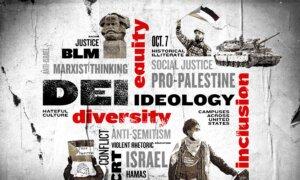As a result of these reports, one could conclude that Canada is an intolerant society, but that may not be the objective reality, says academic David Haskell.
“It creates a perception that Canada is more intolerant than the reality would suggest,” Mr. Haskell, a professor at the faculty of Liberal Arts at Wilfred Laurier University, told The Epoch Times. “We are moving outside of objective reality, to subjective perception.”
‘Made to Feel Uncomfortable’
For example, the StatCan report on discrimination in sports lists types of discriminatory behaviour, the most common of which was being “made to feel uncomfortable.” Respondents also described discriminatory behaviour as “opportunities were denied” and “unfairly penalized or punished.”Accurate surveys about discrimination should try to determine whether there is a clear connection to discrimination, Mr. Haskell said.
“At one time, we had a very clear definition of what racism was,“ he said. ”It was clearly tied to race because the [perpetrator] said it was.”
Mr. Haskell said he’s not the only one talking about how subjective “discrimination” has become. At the University of Melbourne, psychologist Nick Haslam has coined the term “concept creep,” related to an “ever-increasing sensitivity to harm” that reflects “a liberal moral agenda.”
Concept creep “runs the risk of pathologizing everyday experience and encouraging a sense of virtuous but impotent victimhood,” he said.
Mark Lipton, a professor at Guelph University’s College of Arts who specializes in DEI, agrees that it can be hard to determine if an act is discriminatory.
In the case of an assault, for example, “it’s hard to say if it’s a race-based assault unless assault came with a racist slur,” he told The Epoch Times.
Nonetheless, he advocates for calling people out about their unconscious biases in a respectful manner.
It’s difficult to know what criteria the Canadian Human Rights Commission uses to decide whether a case involves discrimination without an objective definition, he said.
What Is Considered ‘Discriminatory’ in Recent Reports
In the report on discrimination in the B.C. legislature, many of the instances mentioned were heated debates during question period.MLAs surveyed by consultancy group ADR Education spoke of “bullying” and shouting. Some said young indigenous women were treated with less respect.
One, however, noted that heated debate is part of the political and democratic process.
Another cited lack of onsite childcare, leaving MLAs with children feeling unsupported.
The majority of B.C. MLAs are New Democrats, whose party is known for having a strong DEI focus. Similarly, Mr. Haskell noted, the Canadian Human Rights Commission—whose members allege widespread discrimination within—are highly committed to DEI and “anti-racism.”
People so steeped in DEI tend to see racism more frequently, he said. He cited an example from the Faculty of Social Work at his university, Wilfred Laurier.
The former dean, who is female and black, accused indigenous staff of racism. They in turn accused her of racism. The conflict ultimately required an outside arbiter, who determined that neither was being racist.
“It’s social work,” said Mr. Haskell. “You can’t get a discipline that is more preoccupied with determining racism.”
He said it’s becoming difficult to believe academics, “because those academics who are the experts are getting it wrong.”
The Senate report on discrimination in the Canadian Human Rights Commission noted HRC staff concerns that their colleagues were dismissing race-based complaints at a high rate.
While such reports suggest Canadians and national intuitions are racist, Mr. Haskell said more objective measures show racism is decreasing. Surveys since the 1960s have regularly asked Canadians, “Would you allow your son or daughter to marry someone from another race or another ethnicity?” Every year, more people say yes to that question, he said. “That’s a true measure.”
“Increasingly, we’re moving away from very clear definitions of hate, as we’ve seen in the Criminal Code Section 318, and 319, which were fairly rigorous,” he said. “And we’re now moving into the realm of subjectivity, where hate is anything that offends progressive or liberal sensibilities.”







